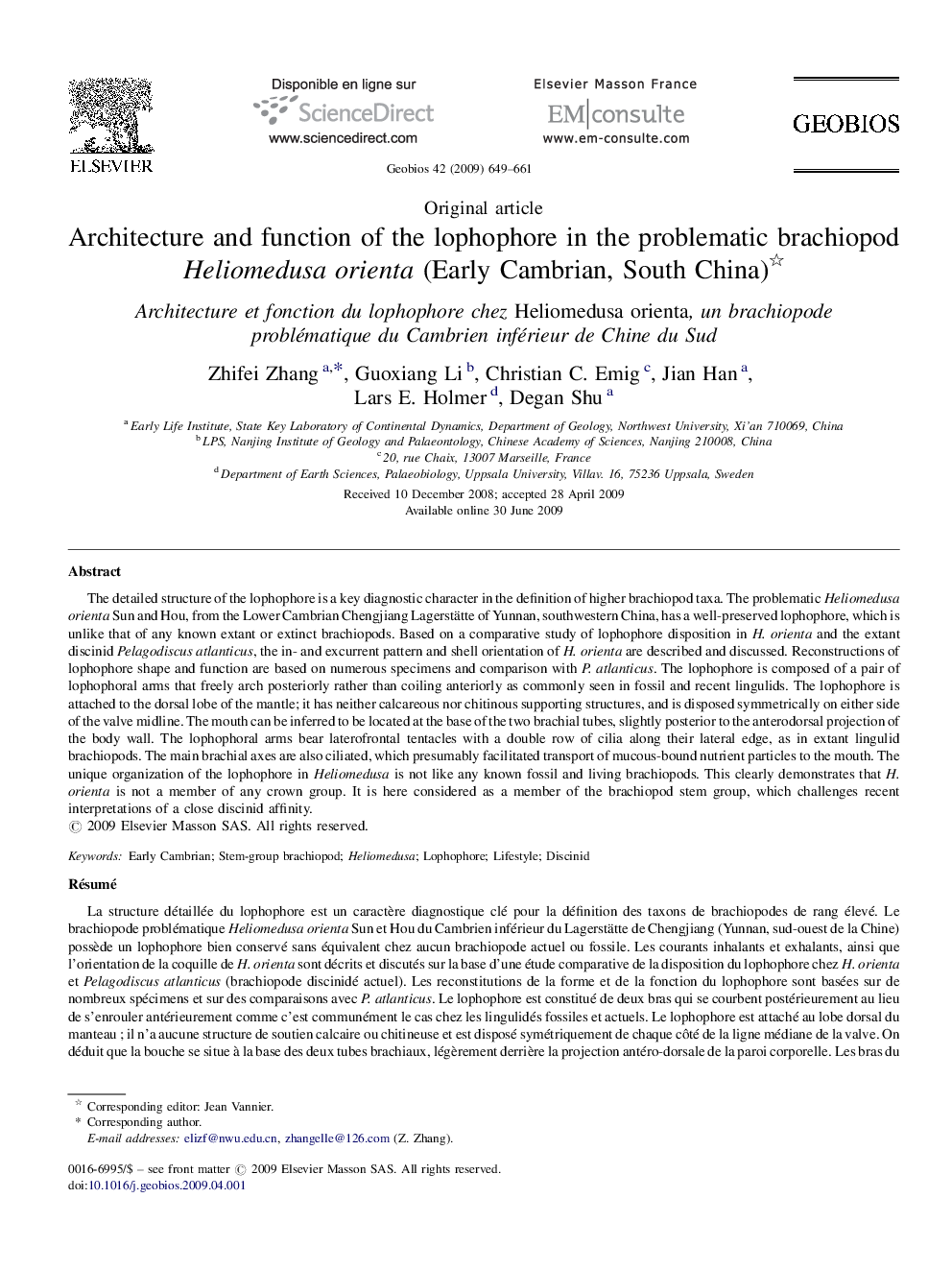| کد مقاله | کد نشریه | سال انتشار | مقاله انگلیسی | نسخه تمام متن |
|---|---|---|---|---|
| 4748369 | 1360101 | 2009 | 13 صفحه PDF | دانلود رایگان |

The detailed structure of the lophophore is a key diagnostic character in the definition of higher brachiopod taxa. The problematic Heliomedusa orienta Sun and Hou, from the Lower Cambrian Chengjiang Lagerstätte of Yunnan, southwestern China, has a well-preserved lophophore, which is unlike that of any known extant or extinct brachiopods. Based on a comparative study of lophophore disposition in H. orienta and the extant discinid Pelagodiscus atlanticus, the in- and excurrent pattern and shell orientation of H. orienta are described and discussed. Reconstructions of lophophore shape and function are based on numerous specimens and comparison with P. atlanticus. The lophophore is composed of a pair of lophophoral arms that freely arch posteriorly rather than coiling anteriorly as commonly seen in fossil and recent lingulids. The lophophore is attached to the dorsal lobe of the mantle; it has neither calcareous nor chitinous supporting structures, and is disposed symmetrically on either side of the valve midline. The mouth can be inferred to be located at the base of the two brachial tubes, slightly posterior to the anterodorsal projection of the body wall. The lophophoral arms bear laterofrontal tentacles with a double row of cilia along their lateral edge, as in extant lingulid brachiopods. The main brachial axes are also ciliated, which presumably facilitated transport of mucous-bound nutrient particles to the mouth. The unique organization of the lophophore in Heliomedusa is not like any known fossil and living brachiopods. This clearly demonstrates that H. orienta is not a member of any crown group. It is here considered as a member of the brachiopod stem group, which challenges recent interpretations of a close discinid affinity.
RésuméLa structure détaillée du lophophore est un caractère diagnostique clé pour la définition des taxons de brachiopodes de rang élevé. Le brachiopode problématique Heliomedusa orienta Sun et Hou du Cambrien inférieur du Lagerstätte de Chengjiang (Yunnan, sud-ouest de la Chine) possède un lophophore bien conservé sans équivalent chez aucun brachiopode actuel ou fossile. Les courants inhalants et exhalants, ainsi que l’orientation de la coquille de H. orienta sont décrits et discutés sur la base d’une étude comparative de la disposition du lophophore chez H. orienta et Pelagodiscus atlanticus (brachiopode discinidé actuel). Les reconstitutions de la forme et de la fonction du lophophore sont basées sur de nombreux spécimens et sur des comparaisons avec P. atlanticus. Le lophophore est constitué de deux bras qui se courbent postérieurement au lieu de s’enrouler antérieurement comme c’est communément le cas chez les lingulidés fossiles et actuels. Le lophophore est attaché au lobe dorsal du manteau ; il n’a aucune structure de soutien calcaire ou chitineuse et est disposé symétriquement de chaque côté de la ligne médiane de la valve. On déduit que la bouche se situe à la base des deux tubes brachiaux, légèrement derrière la projection antéro-dorsale de la paroi corporelle. Les bras du lophophore portent des tentacules latéro-frontaux avant une double rangée de cils le long du bord latéral, comme chez les lingulidés actuels. Les axes brachiaux principaux sont également ciliés, ce qui facilitait vraisemblablement le transport de particules nutritives recouvertes de mucus vers la bouche. L’organisation du lophophore de Heliomedusa est unique et ne se retrouve chez aucun autre brachiopode actuel ou fossile. Ceci démontre clairement que H. orienta ne fait pas partie d’un groupe couronne. Cette espèce est considérée ici comme appartenant au groupe souche (stem group) des brachiopodes, ce qui remet en cause de récentes interprétations selon lesquelles H. orienta aurait d’étroites affinités avec les discinidés.
Journal: Geobios - Volume 42, Issue 5, September–October 2009, Pages 649–661